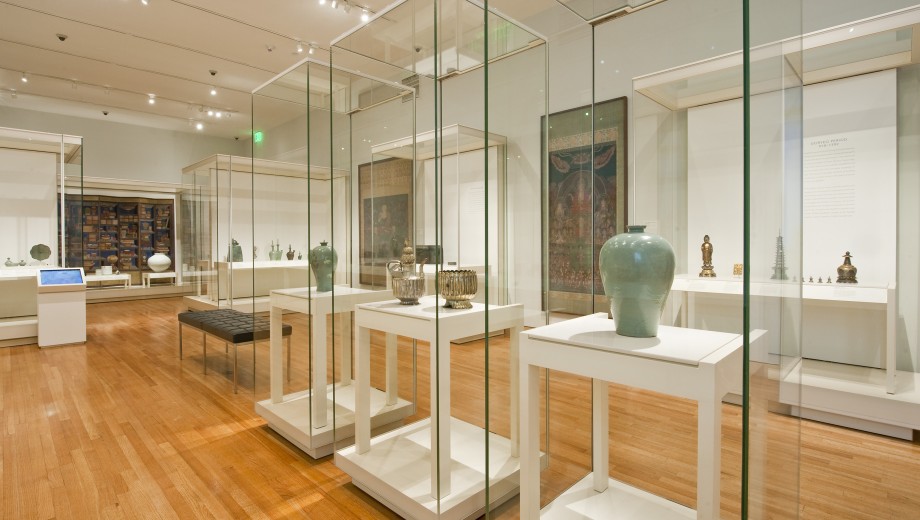In “A Poet and His Patrons,” Tableau spoke with Eric Elshtain, PhD’10, about his work as part-time poet in residence at the Field Museum. Here is a broader conversation about museum careers with Elshtain and two other alumni: Gina Costa, AM’86, an independent curator, photographer, and marketing and public relations director at the University of Notre Dame’s Snite Museum of Art, and Christina Yu Yu, PhD’11, the Matsutaro Shoriki Chair of Asian Art at the Museum of Fine Arts, Boston.
Can you describe your roles?
CY: As a curator, my primary responsibility is to take care of our permanent collection, which means I research the collection and share that information with our visitors. In many ways, curators are storytellers: we want to make our objects attractive and appealing to visitors. The most traditional way to do that is to put them on display. In the digital age, we’re also thinking about how to tell those stories online. We work with students from kindergarten to graduate school, and with the general public. We try to create many layers to the story we’re telling with all these different audiences in mind.
GC: I came to the Snite Museum as a curator of education and a professor of art history. My work now is mostly in marketing and communications, but I also am a curator of twentieth-century Mexican graphics. I do curatorial work for other institutions, mostly in Italy—it’s more freelance, but it gives me a lot of creative opportunity.
EE: When I started my residency, the Field first had me set up appointments with their researchers and scientists so I could get a sense of the scope of their holdings and active research. That sowed the seeds for writing poems based on those conversations.
They left up to me how I wanted to interact with museum visitors. I decided to sit at a portable desk, writing my own poetry and helping visitors compose their thoughts into short poems. It’s my firm belief that everybody has at least one poem inside of them—maybe not a great poem, but a poem. And people are so delighted when it happens.
How has the pandemic affected your work?
GC: We were able to pivot quickly and agilely and create online engagement opportunities for the public. Some of these include deep dives into the collection, insight videos with the museum’s director, and family programs.
EE: The Field already had pretty strong online outreach, and they’ve used that foundation to create downloadable science units, lesson plans, and virtual tours through the museum, as well as field guides to local wildlife. The idea is to broaden the boundaries of the museum into people’s backyards and neighborhoods.
They asked me to create poetry-based prompts for those projects, which are based on the types of prompts I used when I was sitting at my little portable desk in the museum. I’m happy that poetry is a part of the continuing outreach.
CY: We hope people will come back to museums, because nothing can replace having the awe and the inspiration you get when you’re in front of a real piece of art. But at the same time, we understand that it is a challenging time.
More people are looking at online collections, and we think we can make them more engaging and robust. For a while, many museums were just putting up an image of an object and basic information. Maybe there’s a way to share some of our research results or invite people to contribute their comments, so there’s a little more of an interactive aspect that you would get when you went to a museum in person before.
What drew you to working in museums?
EE: At the Field Museum, people go to see the T. rex, Sue; the mummies; and the gem room. Typically, they’re with their kids and they’re on a strict time frame. My thought was, because people have limited time, they’re walking through with questions that, most likely, remain unanswered because they wouldn’t know who to ask or even how to ask those questions. I provide them with an outlet, if they so choose, for those thoughts and questions.
CY: Interaction with the real objects. Every time I have the opportunity to hold those 100,000-year-old objects in my hand—nothing can replace that thrill.
I’m also interested in how we can share ancient art with the public. That’s what’s very different about working in a museum versus working in a university. It’s a much broader audience, and visitors may not have any background in the history of the objects. Sharing what I know and hearing the public’s feedback—which a lot of times inspires what I want to learn more about—is a very appealing part as well.
GC: One of the lovely things about museum work is that I can share my passion for teaching in the museum setting, and we have the objects right there.
It is one of the best careers. You’re not going to be paid very much, and you’re going to have to ride the waves economically, because the arts in the United States are not funded like they should be. Still, there are few things as satisfying as being with works of art that are really stories about our shared histories, our cultures.

